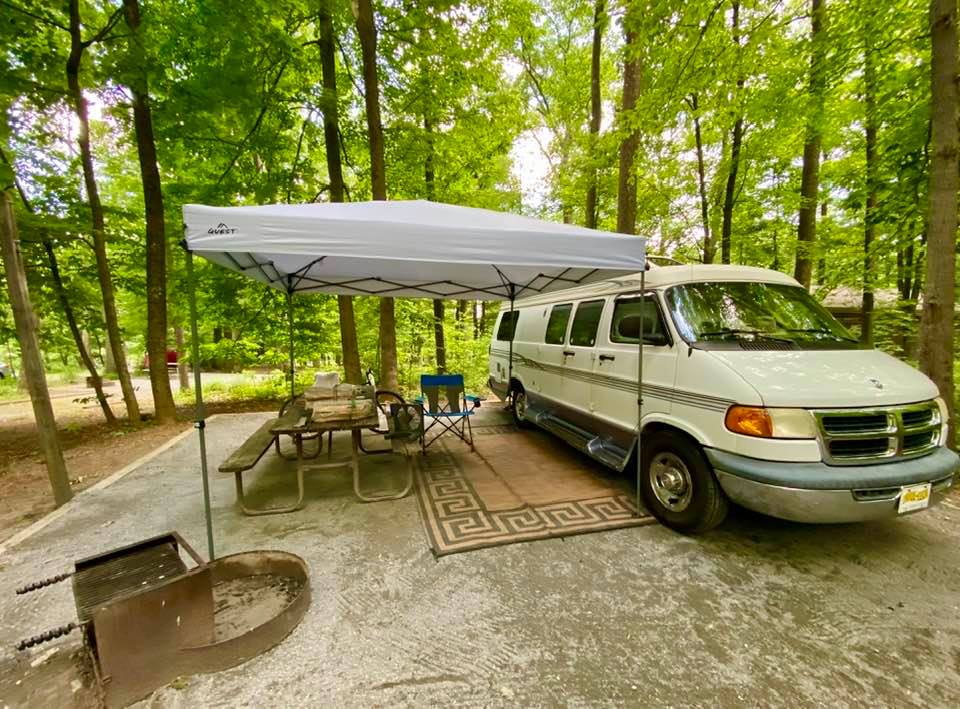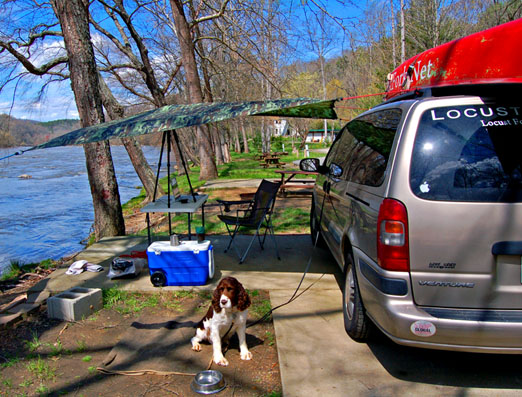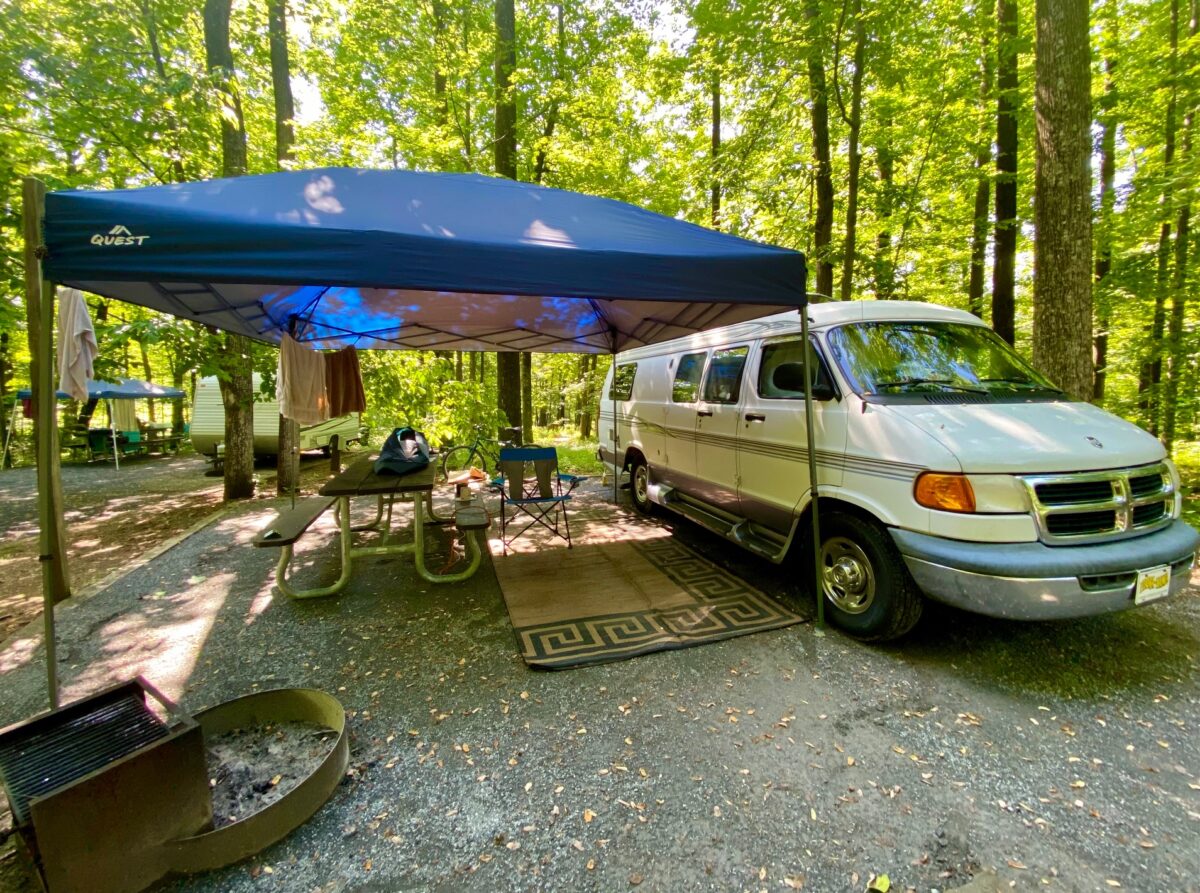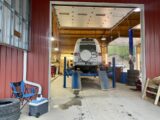CAMPING EAST –
By Glynn Wilson –
CATOCTIN MOUNTAIN, Md. — It’s only the first official week of summer and it’s already peaking out at 91 degrees, according to the official forecast in the nation’s capital today. But here, in the campground in the shade, it’s only 83 degrees, according to the New American Journal indoor-outdoor weather station.
It’s quite pleasant outside here, in shorts and a T with a small fan running. Trying out a new $8 swimsuit. If it gets hot enough, I may go jump in the lake nearby. A lot of people seem to be doing it.
The high hit 106 in Portland, Oregon today, by contrast, in a place many people don’t even have air conditioning, because it’s so rarely been needed in the past.
Clearly global warming is no myth or hoax, as some mixed up people like to claim. It’s driving the climate to change. The very real effects are all around us to see. This is no longer a future projection, and we clearly have not done enough to get ready for this.
So I was hanging out in a camp chair in the shade on Monday reading The New York Times and checking Facebook on the iPhone when a professor of English from the University of the Potomac approached to ask about the camper van.
He was car and tent camping a couple of sites down the way with his wife, daughter and three granddaughters, including one curious girl wearing a summer dress decorated with dinosaurs, named Charlie. Apparently the camping thing was working out as an inexpensive, fun thing to do with the family, or the “fam-damily” as that character in “A River Runs Through It” always said.
They noticed my van and apparently thought it might be a good option to explore for their situation. After awhile, some people get tired of sleeping on the ground in a tent and start looking for RV or Recreational Vehicle options.
You can drive around and camp in a big Winnebago style RV, pull a trailer behind an SUV or pickup truck, or go with the van option, which in many ways is much easier to drive and park and deal with, especially in short term camping situations when you are going to be moving around a lot and visiting cities like Washington, D.C., Philadelphia or New York, for example.
As I was briefing the professor on options to look for, I mentioned the new Facebook group I just started last week to begin telling more stories and offering informed advice on camping in the Eastern United States.
Nomadland East: A Guide to Camping in the Eastern U.S.
The Academy Award-winning movie “Nomadland” was set in the West, and many people know about camping out there, where the people are suffering from a severe drought and heat wave.
Many regular, long-time readers know all my stories by now. But we are always running into new people who don’t. So I’m going to begin by going back to the beginning and relating the story of how and why we ended up becoming long-term, van-living nomads in the first place. This will provide an archive of our experiences for others to enjoy and learn from for years to come.
Back to the Beginning
So it’s coming up on seven years now since I first set out in a media camper van with my loyal dog Jefferson to explore what’s often referred to as the Mid-Atlantic region of the United States.
That first year in 2014 the goal was to investigate all the campgrounds I could find within about a 100-150 mile radius of Washington, D.C.
We actually set out in September, a bit late in the camping season to get started, but the timing was precipitated by a couple of events. Number one, we had a photograph picked up by the Smithsonian’s National Museum of the American Indian and I wanted to be there for the opening of the exhibit.
Smithsonian Opens ‘Nation to Nation’ Treaty Exhibit in National Museum of the American Indian
Number two, we had found a retirement community for my 86-year-old mother and put the house on the market in Birmingham, Alabama, and it ended up selling about the time of the planned trip.
After camping in Shenandoah National Park and other federal campgrounds, Virginia State Parks, Maryland State Parks and some private campgrounds for about three months (I will talk more about them in future stories and posts), I had a pretty good idea of the best places to stay in the area.
I mean it’s not like you can pull up and park on the National Mall and plugin and camp a media camper van overnight. I guess you could try boondocking there, but you would most likely just get hassled by the DC Metro Police.
You have to find campgrounds, preferably with electric power hookups and in range of a cell phone tower for internet access on a WiFi HotSpot. Shade is also an important friend, especially in the hot summer months. So you look for campgrounds in the woods in range of your destination.
The temperature started dropping below freezing in late November that year, and the campgrounds started closing for the season anyway, so I camped my way back south to the Gulf Coast for the winter and started applying for volunteer camp hosting positions in state and federal parks for the next spring and summer.
Activist and writer David Underhill in Mobile had offered me his house in the garden district as a winter haven, and it quickly turned into a Southern Bureau newsroom for the New American Journal. We used it as a winter base until November, 2019, when Underhill tragically died.
Mobile Writer and Activist David Underhill Dies at 78
Prequel
Before that, I traveled around and camped in the spring and fall mostly in a Chevy van with a canoe on top I purchased back in 2005 with the money I made covering the HealthSouth-Scrushy trial for The New York Times. It was a great car, and we covered many stories on the road in it with a laptop and a portable table, including the BP oil spill in 2010.
Even before that, I had a big white Ford Econoline van with a mattress and hammock in the back and a canoe on top I purchased from civil rights photographer Spider Martin back in the early 1990s. So I’ve been a van camper for more than 30 years. Sleeping on the ground in a tent has not much appealed to me since I was a kid. Car-tent camping is for tourists.
Serious back country hikers who camp along the trails like the Appalachian Trail are a bit too serious for me, although I have a few close friends who do it all the time. Some have been all over the world doing it.
I’m a child of the suburbs and like my creature comforts such as a soft bed, a comfortable chair, internet access and the entertainment of movies, which these days you can get with streaming services like Netflix for $8 a month.
About the time I made the decision to adopt a dog while helping to take care of my elderly mother and let her remain in her home she had lived in since 1960, I decided it was time to find a van to use year-around. The Dodge Roadtrek conversion camper van had heat and AC, a kitchen and bathroom of sorts, in addition to the bed in the back. I first saw one on the way to New Orleans for one of the anniversaries of Hurricane Katrina, and started looking them up online.
With a 10 X 10 canopy setup outside, you are not living in a van. You are mostly living outside, which any psychologist will tell you is good for your health and mental health. You just have a place to sleep inside with climate controls, and a place to hang out and watch TV at night or when it’s too cold, windy or rainy, in addition to the work station desk I built in the back of the Dodge van I travel in now. It’s as comfortable to live and work in as any apartment or house I ever lived in, and you can move on with a few minutes notice if the going gets weird.
Van Advice
So what I ended up telling the professor interested in the van was that he should look on the web for a 2007 Chevrolet Roadtrek camper van. If I had the budget to upgrade, that’s what I would be looking for. After camping out here for nearly seven years, I’ve talked to numerous people about various vehicle options and looked at all the options myself.
While camp hosting in the Big Meadows Campground in Shenandoah National Park back in 2015, I noticed this beautiful new-looking gold Chevy Roadtrek and approached the owner one morning. He turned out to be a retired CIA agent who went on to tell me how Roadtrek got everything right in that era, between about 2006-2008, and created the perfect camper van.
I told the professor how I met a couple from Florida in one back in 2018 in Greenbelt National Park near D.C. who were on the run from a hurricane. They had purchashed the van like new with only a few thousand miles on it from an older couple who had bought it new for the express purpose of evacuating Florida in the event of a hurricane. Since Florida went about 10 years without a mandatory hurricane evacuation, the van never got used. It sat in a garage, holding its value. While they sold for $65,000 new back then, the couple picked this one up about 10 years old for $45,000.
So it can be an expensive proposition. You can get an RV or a van for less and fix it up yourself, like Fern did in “Nomadland.” I wanted a van designed for a year-around, long term purpose. It only required a few minor modifications to turn it into a media van. Mine is a 1999 Dodge I found in Rockface Georgia and negotiated the price down to $10,500. I probably spent another $2500 or so fixing it up.
It is approaching 198,000 miles now, and has its problems, so if there is a rich donor or a corporate sponsor out there who likes our work and wants to donate a newer one, we could fix this one up a little and turn it into a crew van.
As we build up our news operation, we hope to eventually employ more of a crew to produce even more news and videos with the mission to save democracy and the planet. Get onboard. We are willing to answer your questions about the news or camping, but we are asking for tips.
Thanks and have a great summer. Stay cool if you can, and get outside when possible.
See you down the MoJo Road, my friends, or somewhere out on the trail.
Make your contribution today!

















